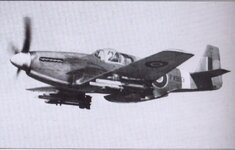N4521U
Plastic Pirate

Shown here is Mustang Mk.III, (FX893) being used for armament trials.
Note that the plane is equipped with unusual rocket rails,
each carrying a 27 kg (60 lb) SAP rocket above and below
so that the single hardpoint on each wing could serve to launch two pairs of RPs.
Like all RAF Mustang Mk.IIIs it is fitted with the Malcolm hood.
So, I found this interesting P-51B in our Black and White photo section of this forum.
Does anyone have a source for the details of the 4 rocket cluster arrangement?
I have found a build on the www of this AC and it was painted with the underside Yellow.
Not unlike the German captured Allied aircraft flown with German markings for evaluation.
It looked pretty ugly with a Yellow belly! Any thoughts by anyone here?
I also found this in my searches.
North American P-51B-1-NA Mustang/43-12384
Model: NA-102
Construction #: 102-24832
Delivered to U.S. Army Air Force
Allocated to the Royal Air Force as Mustang III/FX895.
Broke up in air and crashed near Coolham, April 19, 1944
